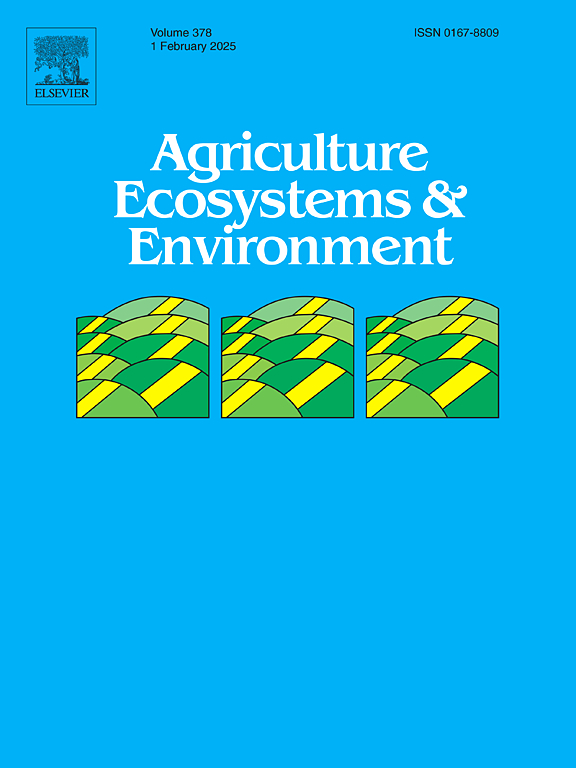黄土高原黑麦草间作与残茬混作在水氮竞争最小的条件下提高苹果产量,减少氮素损失
IF 6
1区 农林科学
Q1 AGRICULTURE, MULTIDISCIPLINARY
引用次数: 0
摘要
覆盖作物在中国西北黄土高原的苹果园中广泛间作。一般来说,覆盖作物对土壤水分和氮素条件有重要益处,但这些益处取决于农民如何管理覆盖作物,如覆盖作物的类型、终止其生长的方法以及采用的残留物管理措施。本研究通过为期两年(2022-2023 年)的田间试验,评估了不同覆盖作物间作系统结合残留物还田对土壤水分和氮素动态以及苹果树生长的影响。试验采用了三种间作系统,即苹果-稗(AR)、苹果-油菜(AO)和苹果-紫花苜蓿(AA),并以清洁耕作作为对照。在土壤水动态方面,三种间作系统的平均蒸散量分别增加了 3.5 %(AR)、3.4 %(AO)和 2.2 %(AA)。此外,在三种间作系统中,土壤水分差异比为负值且与对照有显著差异的出现频率分别为 1 次(AR)、2 次(AO)和 3 次(AA)。不同深度的土壤水分对黑麦草生长的贡献率分别为 41%(0-20 厘米)、37.1%(20-60 厘米)和 21.9%(60-100 厘米),苹果树的相应值分别为 34.4%、16% 和 49.7%。在土壤氮素动态方面,三种间作系统分别提高了苹果树 15NUE 的 40.9 %(AR)、16.1 %(AO)和 14.1 %(AA)。AR 覆盖物的 15NUE 最低(19.7%),而 AA 最高(39.4%)。所有间作系统都明显降低了 15N 损失率(p < 0.05),0-60 厘米土层的总氮增加了 16.9 %(AR)、9.4 %(AO)和 7.7 %(AA)。在苹果树生长方面,AR 在 2022 年使苹果产量和作物水分生产率(WPc)分别提高了 11.7% 和 5.4%,在 2023 年分别提高了 9.8% 和 9.1%;而 AO 在 2022 年使苹果产量和 WPc 分别提高了 5.7% 和 0.5%,在 2023 年分别降低了 2.4% 和 3.6%;AA 在这两年均有所降低。因此,黑麦草与残茬还田间作因其水氮竞争小、土壤氮素流失少、果实产量高而被推荐用于黄土高原的苹果园管理。本文章由计算机程序翻译,如有差异,请以英文原文为准。
Ryegrass intercropping with residue incorporation enhances apple yield and reduces nitrogen loss despite minimal water–nitrogen competition on the Loess Plateau, China
Cover crops are widely intercropped in apple orchards on the Loess Plateau, Northwest China. Generally, there can be important benefits for soil water and nitrogen conditions, while these benefits depend upon how the farmers manage the cover crops, such as the type of cover crops, the method used to terminate their growth, and residue management practices employed. Through a two-year field experiment (2022–2023), this study assessed the effects of different cover crop intercropping systems combined with residue returning on soil water and nitrogen dynamics and apple tree growth. Three intercropping systems, i.e., apple–ryegrass (AR), apple–oilseed rape (AO), and apple–alfalfa (AA) were conducted against clean tillage as a control. In terms of soil water dynamics, three intercropping systems led to an average increase in evapotranspiration of 3.5 % (AR), 3.4 % (AO), and 2.2 % (AA) respectively. Moreover, among three intercropping systems, the frequency of occurrence where the soil water difference ratio was negative and significantly differed from the control was once (AR), twice (AO), and three times (AA) respectively. The contributions of soil water from different depths to ryegrass growth were 41 % (0–20 cm), 37.1 % (20–60 cm), 21.9 % (60–100 cm), and the corresponding values were 34.4 %, 16 %, and 49.7 % for apple trees. Regarding soil nitrogen dynamics, three intercropping systems promoted apple trees 15N use efficiency (15NUE) by 40.9 % (AR), 16.1 % (AO), and 14.1 % (AA), respectively. The AR exhibited the lowest cover crop 15NUE (19.7 %), while AA had the highest (39.4 %). All intercropping systems significantly reduced 15N loss ratio (p < 0.05), with total nitrogen in 0–60 cm soil layer increasing by 16.9 % (AR), 9.4 % (AO), and 7.7 % (AA). As for apple tree growth, the AR increased apple yield and crop water productivity (WPc) by 11.7 % and 5.4 % in 2022, and by 9.8 % and 9.1 % in 2023 respectively; while the AO increased apple yield and WPc by 5.7 % and 0.5 % in 2022, it reduced them by 2.4 % and 3.6 % in 2023; and the AA decreased them in both years. Thus, ryegrass intercropping with residue returning is recommended for apple orchard management on the Loess Plateau due to its negligible water–nitrogen competition, decreased soil nitrogen loss, and enhanced fruit yield.
求助全文
通过发布文献求助,成功后即可免费获取论文全文。
去求助
来源期刊

Agriculture, Ecosystems & Environment
环境科学-环境科学
CiteScore
11.70
自引率
9.10%
发文量
392
审稿时长
26 days
期刊介绍:
Agriculture, Ecosystems and Environment publishes scientific articles dealing with the interface between agroecosystems and the natural environment, specifically how agriculture influences the environment and how changes in that environment impact agroecosystems. Preference is given to papers from experimental and observational research at the field, system or landscape level, from studies that enhance our understanding of processes using data-based biophysical modelling, and papers that bridge scientific disciplines and integrate knowledge. All papers should be placed in an international or wide comparative context.
 求助内容:
求助内容: 应助结果提醒方式:
应助结果提醒方式:


